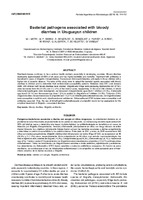Please use this identifier to cite or link to this item:
http://sgc.anlis.gob.ar/handle/123456789/57| Title: | Bacterial pathogens associated with bloody diarrhea in Uruguayan children | Authors: | Mota, María Inés Gadea, María del Pilar Gonzalez, S. Gonzalez, G. Pardo, L. Sirok, Alfredo Rivas, Marta Algorta, G. Schelotto, Felipe Varela, Gustavo |
Keywords: | Diarrea;Shigella;Antibacterianos;Bacilos Gramnegativos Anaerobios Facultativos;Hemorragia Gastrointestinal;Farmacorresistencia Bacteriana Múltiple;Campylobacter jejuni;Uruguay | Issue Date: | 2010 | Journal: | Revista Argentina de Microbiología | Abstract: | Diarrheal disease continues to be a serious health problem, especially in developing countries. Bloody diarrhea represents approximately 20-30% of all cases and has higher morbidity and mortality. Treatment with antibiotics is beneficial in cases of Shigella, Campylobacter, Yersinia and Salmonella infection, principally in those children with a higher risk of invasive disease. The aims of this study were to detect the bacterial agents associated with bloody diarrhea in children and to determine their antimicrobial susceptibility patterns. Between June 2001 and January 2008, 249 children with bloody diarrhea were studied. Shigella and Shiga toxin-producing Escherichia coli (STEC) were recovered from 48 (19.3%) and 3 (1.2%) of the total of cases, respectively. In 49 out of 249 children, in whom other enteropathogens were investigated, we recovered Campylobacter jejuni from 7 children (14.3%), Salmonella spp. from 2 (4.1%) and Aeromonas spp. from 1 (2%) in addition to Shigella from 7 children (14.3%). Thirty-four (70%) Shigella isolates showed resistance to ampicillin and 13 (27%) to trimethoprim-sulfamethoxazole. All Shigella isolates were susceptible to nalidixic acid, ciprofloxacin and ceftriaxone. Salmonella and STEC isolates were susceptible to all antibiotics assayed. Thus, the use of trimethoprim-sulfamethoxazole or ampicillin would not be appropriate for the empirical treatment of Shigella – associated diarrhea. |
Description: | Fil: Mota, María Inés. Instituto de Higiene Arnoldo Berta. Facultad de Medicina. Departamento de Bacteriología y Virología; Uruguay. Fil: Gadea, María del Pilar. Instituto de Higiene Arnoldo Berta. Facultad de Medicina. Departamento de Bacteriología y Virología; Uruguay. Fil: Gonzalez, S. Instituto de Higiene Arnoldo Berta. Facultad de Medicina. Departamento de Bacteriología y Virología; Uruguay. Fil: Gonzalez, G. Instituto de Higiene Arnoldo Berta. Facultad de Medicina. Departamento de Bacteriología y Virología; Uruguay. Fil: Pardo, L. Instituto de Higiene Arnoldo Berta. Facultad de Medicina. Departamento de Bacteriología y Virología; Uruguay. Fil: Sirok, A. Instituto de Higiene Arnoldo Berta. Facultad de Medicina. Departamento de Bacteriología y Virología; Uruguay. Fil: Rivas, M. ANLIS Dr.C.G.Malbrán. Instituto Nacional de Enfermedades Infecciosas. Servicio de Fisiopatogenia; Argentina. Fil: Algorta, G. Instituto de Higiene Arnoldo Berta. Facultad de Medicina. Departamento de Bacteriología y Virología; Uruguay. Fil: Schelotto, F. Instituto de Higiene Arnoldo Berta. Facultad de Medicina. Departamento de Bacteriología y Virología; Uruguay. Fil: Varela, G. Instituto de Higiene Arnoldo Berta. Facultad de Medicina. Departamento de Bacteriología y Virología; Uruguay. |
URI: | http://sgc.anlis.gob.ar/handle/123456789/57 http://www.scielo.org.ar/pdf/ram/v42n2/v42n2a09.pdf |
ISSN: | 0325-7541 | Rights: | info:eu-repo/semantics/openAccess Open Access Creative Commons Attribution 4.0 International License |
| Appears in Collections: | snrd Publicaciones INEI |
Files in This Item:
| File | Description | Size | Format | |
|---|---|---|---|---|
| Revista Argentina de Microbiología, 2010, 42 114-117.pdf | 147.89 kB | Adobe PDF |  View/Open |
Page view(s)
130
checked on Dec 16, 2025
Download(s)
30
checked on Dec 16, 2025
Google ScholarTM
Check
This item is licensed under a Creative Commons License


